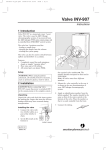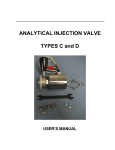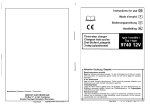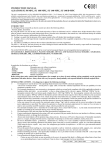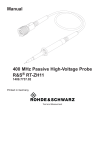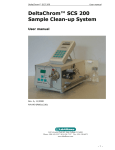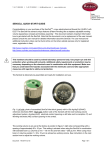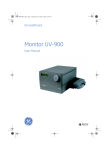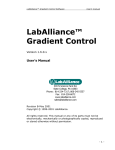Download ECD 200 - Scientific Systems | HPLC Pumps, Systems
Transcript
MODEL ECD-200 ELECTROCHEMICAL DETECTOR USER'S MANUAL 349 N Science Park Rd., State College PA 16803 Phone: 800-345-5557 / 814-234-7317 Fax: 814-238-6072 www.laballiance.com INTRODUCTION We remind to you that the model ECD-200 must be standardized and checked by the user. LabAlliance is not responsible for wrong results due to a bad standardization. This instrument is guaranteed for one year against defects in materials and workmanship. This guarantee does not include the glassy carbon working electrode, the reference electrode, and the auxiliary electrode. For any inquiry or request for repair service, contact your Distributor. CONTENTS 1. OVERVIEW 1.1 1.2 1.3 The electrochemical detection in HPLC Unpacking Technical data 2. THE ELECTROCHEMICAL CELL 2.1 Setting up of the cell 2.2 Mounting of the cell 3. THE EL ECTRODES. 3.1 3.2 3.3 Reference electrode Working electrode Auxiliary electrode 4. ELECTRICAL CONNECTIONS 4.1 Power connection 4.2 Connecting the cell 4.3 Connecting the recorder / integrator 5. PUNCTIONS OF THE MODEL ECD-200 5.1 Description 5.1.1 Front panel (Fig 2 page 10) 5.1.2 Rear panel (Fig 3 page 17) 5.2 Faraday cage (Fig 4 page 18) 6. OPERATION 6.1 6.1.1 6.2.2 6.2 6.3 6.4 Starting up Setting of the cell Switching on Selection of the parameters Selection of the sensitivity Shutting down of the detector 7. FIGURES 7.1 7.2 Rear panel FARADAY cage 8. TROUBLESHOOTING 9. MAINTENANCE 9.1 9.1.1 9.1.3 9.1.4 9.2 9.2.1 9.2.2 9.2.3 9.2.4 10. R. S. 232 COMMANDS Maintenance of the cell Replacement of the PTFE seal Cell leakage Air bubbles Maintenance of the electrodes Reference electrode RE3 Working electrode Auxiliary electrode Electronic test control 10.1 10.2 10.3 10.4 1 Connection Syntax Parameters Shared commands Specific commands for the detector OVERVIEW 1.1 Electrochemical detection in HPLC. Even if you are very familiar with electrochemistry, it is essential that you read this user’s guide to get the best results from the Model ECD-200. 1.2 Unpacking Upon receipt of your instrument, unpack the unit carefully, inspect it for possible damage and check the content of the carton against the list joined. Report any loss or damage immediately to the distributor you purchased the unit from. Potential range: +/- 2 volts by steps of 10 mv Liquid crystal display: The The The The The The The LCD unit is used to display: value of the output in V or nA/V. value of the offset. time constant. withdraw of the base line. chromatogram. sensitivity Sensitivity: 0.05 nA/v to 200 nA/V by 12 steps. Autozero: Actuated by the key board or the injector. Time constant: 0.5s; 2s; 5s. Event marker: By the key board or the injector. Withdraw of the base line: +/-0.9 V by 10 mV steps Two methods saved. Output 1 V or 10 mV FS. Output RS 232 C. Accessory kit which include: Electrochemical cell Reference electrode (2) with O-ring Teflon tubing Fingertights fittings Polishing kit 2 OVERVIEW 2.1 Setting up of the cell The electrochemical cell is a thin layer type, made up of two blocks. Upper-half block: auxiliary electrode. Made in stainless steel. Lower-half block: Block with the working electrode. Figure 1. Electrochemical Cell Assembly Our cells are equipped with PTFE fittings (Ref F 100 available from all the suppliers of HPLC. The Model ECD-200 is compatible with almost all the chromatographs. 2.2 Mounting the cell The cell is located on the right side of the model ECD-200 in a Faraday cage to minimize electromagnetic interferences. This compartment is large enough to contain a chromatographic column. The door of the cage is removable for making adjustments to the cell and connectors, but must be hold in place when running the detector. The cell is delivered ready to use: Make the hydraulic connections with the Teflon tubing and the Fingertights, the inlet is located in the stainless steel block and the outlet in the PTFE block. Set up the electrical connections: Black plug: Working electrode Blue plug: Auxiliary electrode Place the cell in his holder. Turn on the pump. With the mobile phase flowing through the hole of the reference electrode, insert the O-ring into the base of the reference electrode port, take off the plastic cap at the bottom of the electrode and carefully screw the electrode in this port. Finger tightening the reference electrode will ensure a leak proof seal. Never use a wrench because it may cause the break of the electrode. Connect the white plug to the reference electrode. Close the Faraday cage, placing the tubing in the access located on the bottom of the cage door. The cell is ready to be switched on. 3 THE ELECTRODES 3.1 Reference electrode RE3 (Type Ag/AgCl/Cl¯) The body of the cell is made in Kel-F. The electrode is shipped dry and must then be filled up before use with the NaCl (3M) solution provided in the kit. The junction at the bottom of the electrode is in VYCOR and must be kept wet. If the detector must be switched off for more than 24 hours, it is better to remove the electrode from the cell and to replace the plastic cap previously filled with the NaCl solution. The channel inside of the electrode is very small and you can check if there are trapped air bubbles at the bottom of the electrode by gently tapping it while it is vertical. The electrode must always be positioned vertically on the top of the cell. 3.2 Working electrode The working electrode is embedded in the lower block of the cell. This electrode may be in glassy carbon, gold, platinum, silver, or any kind of material on special request. 3.3 Auxiliary electrode The entire upper block in stainless steel is the auxiliary electrode. It contains the mobile phase inlet port, a port for the reference electrode and a hole for the electrical connection. 4 ELECTRICAL CONNECTORS 4.2 POWER 110-120 OR 220-240 V 50/60 Hz Selectable. The detector must be grounded. The color code for the power cord is: Red or Brown Phase Black or Blue Neutral Green or Yellow Ground Warning: Read carefully the set up instructions before you switch on the power. The Model ECD-200 measures very small currents, as the conducting solvent is flowing through all the chromatograph, so it is important to insure that all the elements are connected to the same ground, avoiding the loops of current. 4.2 Connecting the cell The connecting cable is a three-wire with banana plugs that must be connected as follows: BLACK BLUE WHITE Working electrode Auxiliary electrode Reference electrode Warning: Never short circuit two electrodes when the power is switched on. 4.3 Connecting to a recorder or an integrator Two analog signals output are available on the rear panel: 10 mV or 1 V. You can use a simple two-wire cable supplied with the detector. 5 FUNCTIONS OF THE MODEL ECD-200 5.1 Description Model ECD-200 is a microprocessor-controlled detector. A soft-touch key board on the front panel allows all the operations in local mode . For remote operations a computer is linked to the detector by a RS232 cable 5.1.1 Front panel (fig 2 page 10 1 2 to 11 2 3 to 6 7 8 9 10 11 : LCD screen. : Soft-touch keys : Menu Displays various menu. : F1 to F4 functions keys depends on the menu selected. : Cell switch on the cell : SENS call up the sensitivity (and baseline offset)selection menu : Autozero reset the baseline to a predetermined value . : Event marker, perform 3 functions (also available externally) 1) Reset the clock to zero 2) Makes an auto zero 3) Marks the chromatogram. : Time, reset the clock to zero. Six light emitting diodes: 12 13 14 15 16 17 : ON Green: The cell is on. : OFF Red: The cell is off : Overload Current cell is too high. : Autozero Red Now generating an auto zero (Blocks the other functions). :Local Green :Control is from the keyboard. : Remote Green: Control is from a computer. 5.1.2 1. 2. 3. 4. 5. 6. 5.2 Rear panel (Fig 3 page 17 Power switch Power input Fuse box RS 232 socket Analog output 1 V/FS; 10 mV/FS External event marker FARADAY Cage Located on the right side of the detector, the Faraday cage is fitted to hold the cell and eventually the column. A dummy cell is located on the side of the cage and allows you to perform tests. 6 OPERATIONS 6.1 Starting up. Before starting-up, please read carefully this chapter to get the best results with Model ECD-200. 6.1.1 Set the cell in his holder (See 2.2). 6.1.2 Switch the power to ON (Fig 3) The LCD screen briefly display "PRECISION INSTRUMENTS" while making an auto test. 6.2 Selection of the parameters After the test the screen display a preselected working method kept in the memory, the use of this function will be explained later. On this screen using the function keys the user can select several parameters: F1, F2 are used to set the luminosity on the LCD screen. F3 is used to select the time of the chromatogram displayed on the screen: 1; 5; 15; 30; 60 mn. The selected value is displayed in 1. F4 is used to select the value of the time constant: 0; 0.5 ; 2,5 s . Value displayed in 2 . Pressing the MENU key one time displays the POT screen. MENU POTENTIAL The POT screen is used to set the value and the polarity of the potential applied to the working electrode. F1 Increase the value of the potential applied to the working electrode. F2 Decrease the value of this potential. F3 Select the polarity of the potential A sign -before the value appeared when the reduction mode have been selected. F4 Set an automatic auto zero each time the sensitivity is changed. Pressing the menu key displayed the METHOD screen. MENU METHOD Only the function line is modified. This menu is used to store, and recall, a set of parameters in either of two memories. This method is useful for the users working in routine on one or two products. F1 Introduce the parameters displayed on the screen in the memory. F3 Recall automatically this method. Another method may be selected using the F2 and F4 keys Pressing the MENU key displayed the VISU screen. The visual screen is used to configure the display by selecting the parameters displayed on the left part on the screen when the right one is occupied by the chromatogram. F1 Select the value of the output signal in nA or in V. F2 Value of the offset in nA or in V. F3 Indication of the working potential or the offset on the left part of the screen. F4 Switches the chromatogram display on/off At this time you can select the sensitivity by pressing directly the key SENS (8 fig 2) This menu set up the sensitivity to start the analysis, generally 200 nA and should be recall at any time using the same key: SENS. F1 Increase the displayed value F2 (-) Decrease the value F3 (Base line +) Move the base line to the left of the screen by steps of 10mV. F4 (Base line -) Same function to the right At this time all the parameters have been selected if the user want to save these values he have to press the key MENU until the METHOD screen is displayed and introduce these values in the memory. A second line of keys allows a direct access to precise functions: CELL Switches the cell on or off the led lights green or red according to the choice. SENS Set the sensitivity and move the base line AUTOZERO Bring back the base line to a previous value. EVENT MARKER. TIME Reset the clock to zero. 6.3 SELECTION OF THE SENSITIVITY When all the parameters have been introduced, and the cell switch on, a strong current should be obtained which must decrease to a constant value giving a flat base line 6.4 SHUTTING DOWN OF THE DETECTOR To stop the system: Depress the key CELL, the red led OFF lights. Switch off the main power. Stop the flow. Note: If you are not shutting down the system for a long time , it is better to reduce only the flow rate of the mobile phase a minimum to keep the cell in a stable condition. CAUTION: Saline solutions are used with electrochemical detection. For this reason, when you stop the HPLC system you must wash carefully the system to avoid the build up of crystal and salt deposits. 7 FIGURES 7.1 Rear panel (fig 3) 1. 2. 3. 4. 5. 6. Power switch. Power input. Fuse holder. RS 232 connection. Recorder/ integrator output 1 V/FS, lOmV/FS. External event marker. 7.2 FARADAY CAGE Fig 4 FARADAY CAGE (Side View) 1. Outlet fitting 2. Black banana plug: working electrode 3. Blue banana plug: auxiliary electrode 4. White banana plug: reference electrode 5. Cell 6. Reference electrode 7. Dummy cell 8. Cell holder 9. Tubing access holes 10. Inlet fitting 8 TROUBLESHOOTING Problem Possible Cause Solution No detector response Power cord disconnected. Power OFF. Fuse blown. Voltage set incorrectly. Working electrode not ON Reconnect the cord. Switch ON at rear panel. Replace the fuse. Check, correct Press soft touch 'Cell', green LED is lit when ON. Reconnect the jack plug. Replace the electrode. Check/install pulse damper. Locate and remove. Drop in mobile phase flow. Baseline oscillations Sudden shift of bezel Working electrode disconnected. Working electrode damaged. Pulsations caused by pump. Air bubbles in system. Check pumping system. Flattening of peaks Too much sample. Saturation of detector Output Cell incorrectly connected. Faulty reference electrode. Check reservoir is not empty. Reduce sample size, or dilute it, reduce to 100 ng or less. Check electrical connec6ons. (jack plugs) to cell. Remove trapped air bubbles. Replace reference electrode. Regenerate working electrode. Faulty working electrode. Baseline unstable Trapped air bubble in cell. Air bubbles in outlet tubing, Insufficient liquid in reference electrode assembly. Formation of crystals around reference electrode assembly. Baseline noisy. High level of background noise Hydraulic problems (leakage). Metallic Particles in hydraulics Inadequate grounding. Contamination of the mobile phase. Turn OFF, and eliminate bubbles. Degas mobile phase. Check hydraulic connections. Refill with NaCI (3m) solution or replace assembly. Remove it, clean well with H20 (distilled). Refit, making sure mobile phase does lot leak out. Tighten tubing connections. Clean system, change frits, etc. Make new mobile phase using very pure compounds. 9 9.1 9.1.1 MAINTENANCE Maintenance of the cell Replacement of the PTFE seal. Place the PTFE gasket on the stainless steel half block, line up the sides of the gasket with the sides of the block . The wider end of the gasket should be nearest the reference electrode port . The PTFE gasket is asymmetrical, be sure the two small holes on the stainless steel block are visible in the channel in the middle of the seal. Place the Kel-F block on the stainless steel block so that the gasket is between the two blocks and the port for the reference electrode is lined up with the mobile phase outlet in the Kel-F half block. Return the four screws to the Kel-F block, tighten the screws gradually by alternately tightening the screws which are diagonally across from one another until firm. Caution: Over-tightening the screws can break the cell. 9.1.2 Cell leakage. Clean carefully the parts of the block in contact with the gasket, and replace the seal. 9.1.3 Air bubbles. Air bubbles can significantly degrade the performances of the detector; bubbles can be formed by a non degassed mobile phase The mobile phase can be degassed under vacuum or by increasing the temperature for a short time for aqueous solvent, if the mobile phase contain an amount of organic solvent it is better to use an ultrasonic bath or to flush the solution with a gentle bubbling of helium. 9.2 Maintenance of the electrodes The life of the electrodes depends mainly of the operating conditions, the quality of the solvents and the conductive salt . Although special care is taken in the manufacture of the electrodes no guarantee can be given as to the lifetime of any electrode. 9.2.1 Reference electrode RE3 This electrode act as half a cell, so before mounting the electrode in his port it is very easy to control his potential. You take two reference electrodes, you dip the bottom of the electrode in a NaCl solution, and you measure the potential difference between the electrode using an external voltmeter. This difference must not be higher than 75 mV, if not change the electrode So it is advisable to have several electrodes in stock 9.2.2 Working electrode. The thin layer type cell allows an easy maintenance of the working electrode. A loss of sensitivity points to the necessity of replacing the electrode. 1-Press the key CELL the red led OFF lights 2-Disconnect the three jacks connectors. 3-Remove the cell and disconnect the inlet and outlet tubing. 4-Unscrew the reference electrode and refit the plastic cap. 5-Unscrew the four screws, which hold the two half blocks together, using the Allen key. The working electrode can be rendered passive by sample molecules or by products fixed on the surface . It can be regenerated as follow: 1-Assemble the polishing pad from the kit provided 2-Put one or two drops off the polishing alumina on the wet pad . 3-Polish the electrode by gently rubbing the side containing the glassy carbon electrode on the pad for about one minute . 4-Rinse the electrode with distillated water and reassemble the cell. 9.2.3 AUXILIARY ELECTRODE Generally this electrode don't need any maintenance, but you can clean it at the same time for working electrode and using the same polishing kit . 9.2.4 Electronic test control. Each time that the detector is started up, the electronics are automatically tested. To check that the electronics are working correctly: 1-Switch off the detector (Power switch on the rear panel). 2-Remove the connectors from the cell and then connect them to the dummy cell inside the FARADAY cage . Each jack connects to the socket having the same color (blue white, black 3-Switch on the detector. 4-Move through the screen until you get to the POTENTIAL screen select a potential of 0.50 v 5-Start up the cell by pressing the CELL soft touch key, the green LED lights up. 6-Push the AUTO ZERO key, the red auto zero LED lights indicating an auto zero is being generated 7-When the red light goes out check the output value is near zero and check the OFFSET is 0.50 V +/-10% 10 RS232 COMMMDS 10.1 Connection The connection is made by a standard 9 pins RS232 cable between the female socket at the rear of the detector and the computer. The data transmission rate is 4800 Baud (7 data bits, 1 parity bit and 1 stop bit) The pin out of the 9-pin socket is as follows: Pin 2 receive data Pin 3 transmit data Pin 4 data terminal ready Pin 5 ground Pin 8 clear to send 10.2 Syntax, parameters A maximum of 16 commands may be used. Each command is made up of 16 characters (maximum) terminated by a carriage return (CR), and may include up to 3 parameters. For example: Function Parameter 1 Parameter 2 Parameter 3 CR Where CR=OD hexadecimal, and Function is an alphabetic character code that definite the type of command that is to be executed Five types of parameters exist -Represented by the notation @: switches, which are used to switch between two possible states. These consist of one byte taking either ASCII character 11111 (31 hex), or ASCII’1211 (32 hex); In the case where the switch can be left unchanged this word takes ASCII character “9” (39 hex). -Represented by the notation **: Integers, which are used to determine whole number, consisting of a fixed number of bytes (n) able to take ASCII character “0” to “9”. -Represented by the notation #.### :actual values, consisting of a fixed number of bytes (n) a decimal point (2E hex), and a fixed number of bytes(m). -Represented by the notation +###.## :actual value and sign, consisting of a fixed number of bytes (n), a decimal point (2e hex) and a fixed number of bytes (m),preceded by the sign indicator This character is either - (2D hex) or +(2B hex) . -Represented by the notation xxxx :text, all ASCII characters between 20 hex and 7E hex. 10.3 Shared commands Following are the shared commands of the electrochemical detector R Change to remote mode L Change to local mode A Send auto zero command D+## Set the output offset(-0.95 to +0.95 in steps of 0.05) F* Set the value of the filter, may take the values: 0 0= no filter 1 = 0.5 s 2= 2s 3= 5s I Identification check; returns the programmed string, by default D= detector JXXXX Programming identification: xxxx= a string of characters between 1 and 10. 10.4 C@ Specific commands of the detector Switch the cell ON and OFF @=1 cell off @=2 cell on S@@* Enable automatic auto zero Activate /Disactivate the graphical display (plot)and (optionally) fix the duration of trace . @=I automatic auto zero OFF @=2 automatic auto zero ON @=I disactivate, the plot @=2 activate the plot *=O(lmn),1(5 mn),2(15mn),3(30mn)4(60mn) Z@@@ Set the display options. @=1 displays the offset value in nA @=2 displays the offset value in volts @=1 displays the potential in volt on the right @=2 displays the potential in volt on the left @=1 displays the offset value on the left @=2 displays the offset value on the right G** Set the range 10 12 14 16 18 20 200 nA/V 50 10 2 0.5 0.1 11 13 15 17 19 21 100 nA/V 20 5 1 0.2 0.05 P@#.## Set to either oxidation or reduction and set the potential value @=1 reduction @=2 oxidation #.##=Potential value between 0.00 end 2.54.



























